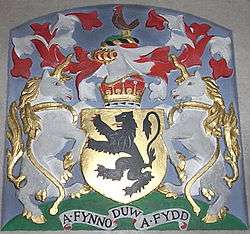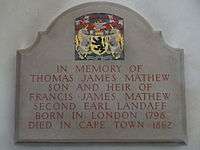Earl Landaff



Earl Landaff, of Thomastown in the County of Tipperary, was a title in the Peerage of Ireland. It was created in 1797 for Francis Mathew, 1st Earl Landaff, who had previously represented County Tipperary in the Irish House of Commons. He had already been created Baron Landaff, of Thomastown in the County of Tipperary, in 1783, and Viscount Landaff, of Thomastown in the County of Tipperary, in 1797, also in the Peerage of Ireland. In 1800 he was elected as one of the 28 original Irish Representative Peers. He was succeeded by his son, the second Earl. The titles became extinct on his death in 1833.[1] Thomastown Castle was the childhood home of Father Theobold Mathew, "The Apostle of Temperance".[2][3]
The Earls Landaff used the invented courtesy title Viscount Mathew for the heir apparent. Despite their territorial designations and the fact that they were in the Peerage of Ireland, the titles all referred to the place in Glamorgan now spelt Llandaff. The Mathew family was founded by Sir David Mathew (died 1484), Grand Standard Bearer of England. The Earls Landaff were descended from the branch of the family seated at Radyr, Glamorgan, Wales, descended from Thomas Mathew (died 1470), a younger son of Sir David Mathew. In Llandaff Cathedral, nearby Radyr, there exist three 15th century and 16th century Mathew family effigies.
The seat of the Mathew family was Thomastown Castle, County Tipperary long abandoned. The extant ruins form a notable landmark.[4] George Mathew sold his estate at Radyr and moved to Thomastown, gaining ownership of the castle through marriage to Elizabeth Poyntz after the death of her first husband, Thomas Butler, Viscount Thurles, of the Butler family.[5] hi
Earls Landaff (1797)
- Francis Mathew, 1st Earl Landaff (1738–1806)
- Francis James Mathew, 2nd Earl Landaff (1768–1833)
Rejected claimants
- Arnold Harris Mathew, self-styled de jure 4th Earl Landaff,[lower-alpha 1] also self-styled Count Povoleri di Vicenza (1852–1919)
He was founder and first bishop of the Old Roman Catholic Western Orthodox Church in Great Britain, an Old Catholic Church. His episcopal consecration was declared null and void by the Union of Utrecht's International Old Catholic Bishops' Conference. Additionally, he was excommunicated and declared vitandus by Pope Pius X for illicitly consecrating two Roman Catholic priests as bishops which led a London jury to find that "the words were true in substance and in fact" that he was a "pseudo-bishop".[13]
See also
Notes
- ↑ Arnold Harris Mathew (AHM) claimed that his great-grandfather was Francis Mathew, 1st Earl Landaff.[6] AHM put forward his claim to the Garter Principal King of Arms for the title of 4th Earl of Llandaff of Thomastown, Co. Tipperary in 1890.[7] AHM just had a pedigree placed on official record at the College of Arms. He did not intend to "definitely determine in the customary method his right to the dignity he claim[ed]" by establishing his right to vote at the elections of Representative Peers for Ireland.[8] He has been advised that all he could hope to obtain would be the barren title.[8] John H. Matthews, Cardiff archivist, said in 1898 that the number of claimants to the dormant earldom "is legion". In the archivist's opinion AHM's published pedigree was "too extra-ordinary to commend itself to an impartial mind."[9] The next year AHM changed his mind. In 1899, his petition to the House of Lords, claiming a right to vote, was read and referred to the Lord Chancellor.[10] In his petition, he wrote that Eliza Francesca Povoleri was a spinster and he did not claim she was the daughter of a Marchese and a Contessa.[6] In 1902, the Lord Chancellor, Hardinge Giffard, 1st Earl of Halsbury, reported that AHM's claim "is of such a nature that it ought to be referred to the Committee for Privileges; read, and ordered to lie on the Table."[11][12]
References
- ↑ Burke, Bernard, ed. (1866). "MATHEW—Earl of Llandaff". A genealogical history of the dormant, abeyant, forfeited, and extinct peerages of the British empire (new ed.). London: Harrison. p. 361. OCLC 4102769.
- ↑ Abandoned Mansions of Ireland photodocumentary book and website by Tarquin Blake. (Accessed 10 June 2012)
- ↑ Catholic Encyclopedia Theobald Mathews, Apostle of Temperance
- ↑ 19th century towers stand while the 17th Century neo-gothic ramparts have succumbed to neglect and collapsed under the weight of encroaching ivy
- ↑ "Mathew of Thurles". Archived from the original on 5 January 2009. Retrieved 2008-06-28.
- 1 2 Mathew, Arnold H. (1899). "[Petition of Arnold H. Mathew to vote at the election of Representative Peers for Ireland]". Journals of the House of Lords. London: Stationery Office. 131: 376. LCCN sn94094788.
- ↑ Hill, Christopher (Jan 2004). "Episcopal Lineage: a theological reflection on Blake v Associated Newspapers Ltd". Ecclesiastical Law Journal. Cambridge University Press. 7 (34): 334–338. ISSN 0956-618X. doi:10.1017/S0956618X00005421.

- 1 2 "Another peerage romance". The Sketch. London: Ingram Brothers. 23 (298): 518. 12 October 1898. LCCN 09033130.
- ↑ "Who is earl of Landaff?". Western mail (9169). Cardiff, Wales. 13 October 1898. p. 6. OCLC 506485542.
- ↑ http://hansard.millbanksystems.com/lords/1899/aug/04/earl-of-landaff
|chapter-url=missing title (help). Parliamentary Debates (Hansard). House of Lords. 4 August 1899. col. 1421. - ↑ http://hansard.millbanksystems.com/lords/1902/jul/10/earl-of-landaff
|chapter-url=missing title (help). Parliamentary Debates (Hansard). House of Lords. 10 July 1902. col. 1301. - ↑ Halsbury, Hardinge Stanley Giffard, earl of (1902). "[Report upon the 'Petition of Arnold H. Mathew to vote at the election of Representative Peers for Ireland']". Journals of the House of Lords. London: Stationery Office. 134: 282. LCCN sn94094788.
- ↑ "Notes". The Tablet. London. 1919-12-27. p. 5. ISSN 0039-8837. Retrieved 2013-08-21.
- Leigh Rayment's Peerage Pages
- Mathew, Rev. Murray Alexander, "The Genealogy of the Earls of Landaff of Thomastown, County Tipperary, Ireland", published by Simpkin, London, 1895. (A rare book)